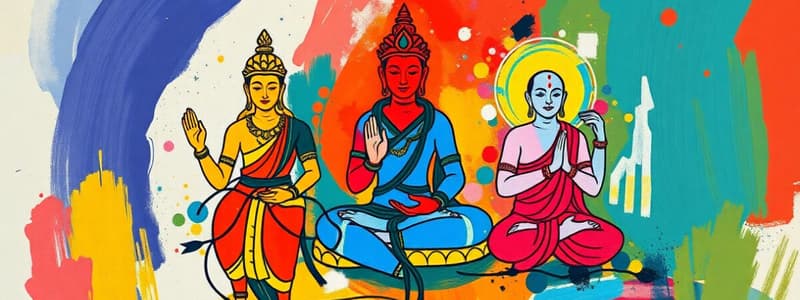Podcast
Questions and Answers
Which of the following chapters of the Quran consist of only three verses each?
Which of the following chapters of the Quran consist of only three verses each?
- Chapter 114
- Chapter 103 (correct)
- Chapter 34
- Chapter 2
What is the literal meaning of the Greek word 'Biblion'?
What is the literal meaning of the Greek word 'Biblion'?
- Papyrus plant
- Book (correct)
- Tablet
- Scroll
In which scripture was the conversation between Krishna and Arjuna held?
In which scripture was the conversation between Krishna and Arjuna held?
- Vedas
- Bhagavad Gita (correct)
- Holy Bible
- Tripitaka
Which of the following is NOT one of the three major sections of the Tripitaka?
Which of the following is NOT one of the three major sections of the Tripitaka?
How many books does the King James Version of the Bible contain for Protestants?
How many books does the King James Version of the Bible contain for Protestants?
Which of the following describes the Rig Veda?
Which of the following describes the Rig Veda?
What does 'Shruti' refer to in the context of the Vedas?
What does 'Shruti' refer to in the context of the Vedas?
What is the primary function of the Vedas in Hindu culture?
What is the primary function of the Vedas in Hindu culture?
What is the primary focus of the Upanishads?
What is the primary focus of the Upanishads?
What are the Vedas collectively known as in Hinduism?
What are the Vedas collectively known as in Hinduism?
Which Veda is primarily composed of hymns?
Which Veda is primarily composed of hymns?
What does the term 'apauruseya' indicate regarding the Vedas?
What does the term 'apauruseya' indicate regarding the Vedas?
What is the significance of the term 'Vedanta'?
What is the significance of the term 'Vedanta'?
What is the Tripitaka in Buddhism commonly known as?
What is the Tripitaka in Buddhism commonly known as?
Which Vedic text is known for containing charms and magical incantations?
Which Vedic text is known for containing charms and magical incantations?
What does the etymology of 'Upanishads' imply?
What does the etymology of 'Upanishads' imply?
What is the primary purpose of the Vinaya Pitaka in Pali literature?
What is the primary purpose of the Vinaya Pitaka in Pali literature?
Which text is considered key in the teachings of Taoism?
Which text is considered key in the teachings of Taoism?
The Analects are primarily focused on what aspect of philosophy?
The Analects are primarily focused on what aspect of philosophy?
Which of the following is NOT a section of the Christian Bible?
Which of the following is NOT a section of the Christian Bible?
What is the role of the Qur'an in Islam?
What is the role of the Qur'an in Islam?
What do the 3 Jewels of Taoist ethics emphasize?
What do the 3 Jewels of Taoist ethics emphasize?
How is the Talmud related to the Torah?
How is the Talmud related to the Torah?
What common belief do Jews, Christians, and Muslims share regarding the Messiah?
What common belief do Jews, Christians, and Muslims share regarding the Messiah?
What comprises the two components of the Talmud?
What comprises the two components of the Talmud?
Which text is NOT part of the Four Books of Confucianism?
Which text is NOT part of the Four Books of Confucianism?
Which philosophical traditions share concepts with the Upanishads?
Which philosophical traditions share concepts with the Upanishads?
Which of the following is a collection of Jewish practices and regulations?
Which of the following is a collection of Jewish practices and regulations?
What is the original name of Confucius?
What is the original name of Confucius?
Which text influenced Legalism alongside Confucianism and Buddhism?
Which text influenced Legalism alongside Confucianism and Buddhism?
What is the primary purpose of the Five Classics in Confucianism?
What is the primary purpose of the Five Classics in Confucianism?
Which of the following is NOT considered a book of the Five Classics?
Which of the following is NOT considered a book of the Five Classics?
Flashcards
Vedas
Vedas
Sacred Hindu texts, considered the oldest Sanskrit literature.
Upanishads
Upanishads
Philosophical texts within the Vedas, focusing on the nature of the world and God.
Vedic Sanskrit
Vedic Sanskrit
The language of the Vedas.
Tripitaka
Tripitaka
Signup and view all the flashcards
Pali Canon
Pali Canon
Signup and view all the flashcards
Rig Veda
Rig Veda
Signup and view all the flashcards
Brahman
Brahman
Signup and view all the flashcards
Tao te Ching
Tao te Ching
Signup and view all the flashcards
Pali
Pali
Signup and view all the flashcards
Vinaya Pitaka
Vinaya Pitaka
Signup and view all the flashcards
Sutta Pitaka
Sutta Pitaka
Signup and view all the flashcards
Abhidhamma Pitaka
Abhidhamma Pitaka
Signup and view all the flashcards
Tao
Tao
Signup and view all the flashcards
Lao-tzu
Lao-tzu
Signup and view all the flashcards
Analects
Analects
Signup and view all the flashcards
Torah
Torah
Signup and view all the flashcards
Bible
Bible
Signup and view all the flashcards
Bhagavad Gita
Bhagavad Gita
Signup and view all the flashcards
What are the 4 main Vedas?
What are the 4 main Vedas?
Signup and view all the flashcards
How many books does the Bible contain?
How many books does the Bible contain?
Signup and view all the flashcards
What is the significance of the Bhagavad Gita?
What is the significance of the Bhagavad Gita?
Signup and view all the flashcards
What are the Upanishads?
What are the Upanishads?
Signup and view all the flashcards
What are the Five Classics?
What are the Five Classics?
Signup and view all the flashcards
What are the Four Books?
What are the Four Books?
Signup and view all the flashcards
What is the influence of Tao Te Ching?
What is the influence of Tao Te Ching?
Signup and view all the flashcards
What is the Talmud?
What is the Talmud?
Signup and view all the flashcards
What is the Mishnah?
What is the Mishnah?
Signup and view all the flashcards
What is the Gemara?
What is the Gemara?
Signup and view all the flashcards
What are the two parts of the Talmud?
What are the two parts of the Talmud?
Signup and view all the flashcards
Study Notes
Sacred Writings
- Sacred writings provide meaning and purpose, and work in connection with the Divine.
Vedas and Upanishads
- Vedas are sacred texts in Hinduism, written in Vedic Sanskrit from India.
- Considered "apauruseya" (not of man) and written in poetic/symbolic form.
- Vedas include: Rig Veda (1028 hymns), Yajur Veda (rituals, sacrifices), Sama Veda (melodies and chants), and Atharva Veda (charms and incantations).
- Vyasa compiled the Vedas.
- Upanishads are part of the Vedas, with over 200 different philosophical texts.
- Upanishads use a more direct and understandable language.
- They are sometimes called Vedanta ("The end portion of the Veda").
Tripitaka
- Tripitaka is a vast collection of Buddhist sacred writings and commentaries on the Words of Buddha.
- Pali Canon, also known as the Three Baskets, is the standard scripture collection of the Theravada Buddhist tradition.
- Written in ancient Pali language of North India.
- The "Bible" of Buddhism, it does not have one singular book, but is written in parts over centuries BCE in Sri Lanka at the Fourth Buddhist Council.
- Three sections: Vinaya Pitaka (rules for monastics), Sutta Pitaka (discourses of the Buddha and his disciples), and Abhidhamma Pitaka ("systematic philosophy" basket).
Tao Te Ching
- Tao Te Ching is a collection of the world's best-loved sacred texts of Taoism.
- Authored by Lao-tzu, who first received inspiration of the Tao, impersonally guiding things through a Natural way.
- Three Jewels of Taoist ethics are compassion, moderation, and humility, or kindness, simplicity, and modesty.
Analects
- The Analects are revered sacred scriptures in Confucianism.
- A collection of Confucius' daily teachings, recorded by his students.
- A socio-philosophical movement aimed at societal betterment and a moral/ethical philosophy.
Bible
- The Bible is a collection of Christian sacred texts.
- History of Christianity begins with Jesus and his apostles.
- Based on Jesus Christ's birth, life, death, resurrection, and teachings.
- Two sections: Old and New Testaments.
Talmud
- Talmud is a collection of Jewish sacred texts, a compilation of "discussion" on the Torah's meaning.
- Torah is all of the Hebrew Bible (including Joshua, Psalms, Book of Ruth, etc.).
- Star of David is a symbol of Judaism and the Jewish people.
- Yahweh is the God of Judaism.
Qur'an (Koran)
- Qur'an is the sacred scripture of Islam, revealed to the Prophet Muhammad by the angel Gabriel.
- God's final revelation to humankind.
- The direct word of Allah to Muhammad.
Four Books (Confucianism)
- The Four Books (Si shu) and Five Classics (Wujing) are foundations of Confucianism.
- The basis of Confucian civil examinations in ancient China.
- The Five Classics include the Book of Odes, Book of Documents, Book of Changes, Book of Rites, and Spring and Autumn Annals.
- From Han to Song dynasty, the 5 Classics grew into 13 classics.
- The Four Books include Doctrine of the Mean, Great Learning, Mencius, and the Analects.
Tao Te Ching (14th Century)
- A fundamental text, along with Zhuangzi.
- Influenced Legalism, Confucianism, and Buddhism.
- Inspiration for poets, painters, calligraphers, and gardeners
Talmud (Holy Book of Judaism)
- Collection of Jewish practices and regulations.
- Babylonian Talmud (Talmud Bavli), a primary source of Jewish religious law (halakha) and Jewish theology.
- Foundational to Jewish thought and aspirations. Two main parts: Mishnah (c. 200) and Gemara (c. 500).
The Kojiki
- Sacred book of Shintoism, written in 712 AD.
- Oldest surviving religion and national religion of Japan.
Shintoism
- Two main scriptures are the Kojiki and Nihon Shoki, which are behind practices like the Misogi purification ritual.
- These contain accounts of ancient matters and accounts of the origin of Japan and the Kami (holy powers).
Studying That Suits You
Use AI to generate personalized quizzes and flashcards to suit your learning preferences.




